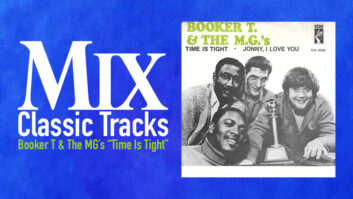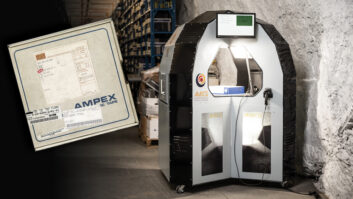
New York, NY (August 19, 2024)—A few years ago, archiving specialist Iron Mountain Media and Archive Services did a survey of its vaults and discovered an alarming trend: Of the thousands and thousands of archived hard disk drives from the 1990s that clients ask the company to work on, around one-fifth are unreadable. Iron Mountain has a broad customer base, but if you focus strictly on the music business, says Robert Koszela, Global Director Studio Growth and Strategic Initiatives, “That means there are historic sessions from the early to mid-’90s that are dying.”
Until the turn of the millennium, the workflow for record releases was simple enough. Once the multitrack was mixed, the 2-track master was turned into a piece of vinyl, a cassette tape or, starting in 1982, a compact disc, and those original tapes—by and large— then went into storage. Around 2000, with the advent of 5.1-surround releases, then in 2005 with the debut of the Guitar Hero video game, things started to get complicated. When rights holders went to the vaults to transfer, remix and repurpose some of their catalog tracks for these new platforms, they discovered that some tapes were deteriorating while others were unplayable. Not all assets had been stored under optimum conditions. Some recordings had been made on machines that were now obsolete, in formats that could no longer be easily played. And some recordings were missing.
In short, for the past 25 or more years, the music industry has been focused on its magnetic tape archives, and on the remediation, digitization and migration of assets to more accessible, reliable storage. Hard drives also became a focus of the industry during that period, ever since the emergence of the first DAWs in the late 1980s. But unlike tape, surely, all you need to do, decades later, is connect a drive and open the files. Well, not necessarily. And Iron Mountain would like to alert the music industry at large to the fact that, even though you may have followed recommended best practices at the time, those archived drives may now be no more easily playable than a 40-year-old reel of Ampex 456 tape.
“The big challenge that we face is just getting the word out there,” says Koszela, who racked up years of experience on the record label side with UMG before joining Iron Mountain Media and Archive Services. Iron Mountain handles millions of data storage assets for a diverse list of clients, from Fortune 500 companies to major players in the entertainment industry, so the company has a significant sample size to analyze, he points out. “In our line of work, if we discover an inherent problem with a format, it makes sense to let everybody know. It may sound like a sales pitch, but it’s not; it’s a call for action.”
CAN YOU PLAY?
Many asset owners—labels, artists, artists’ estates—sleep soundly at night believing that their recordings are safe in a climate-controlled vault, Koszela notes. But just like tape, hard drives are susceptible to any number of issues that may only be discovered when, for example, the project is pulled off the shelf to create an immersive mix.
“It’s so sad to see a project come into the studio, a hard drive in a brand-new case with the wrapper and the tags from wherever they bought it still in there,” Koszela says. “Next to it is a case with the safety drive in it. Everything’s in order. And both of them are bricks.”
Let’s say a drive containing a 1995 session does spin up. “You’ve got to update the Pro Tools session and you’re probably going to have to fix some plug-ins,” Koszela warns. “You’re off to the races, and you can create an immersive mix—but not if you wait too long and let that stuff die.”

A lot has changed in the world of digital media during the past three decades, so legacy disk formats like Jaz and Zip, obsolete and unsupported connections, and even something as simple as a lost, proprietary wall wart for the enclosure can be a challenge with some older archived assets. Based on years of experience, Iron Mountain has developed hubs at its facilities that can power up, connect to and read virtually any storage medium. If the disk platters spin and aren’t damaged, Iron Mountain Media and Archive Services techs can access the content.
As with tape, pulling an archived drive off the shelf and discovering any challenges to playing it will typically only occur if there is a commercial imperative. “Most of the resources are freed up based on exploitation,” Koszela confirms, such as the label’s need for that immersive mix. However, an archived drive may hold an early transfer from tape at a lower resolution than is now the norm. If there’s enough budget, someone may need to go back to the tape and— hopefully, barring any issues—transfer it again at today’s accepted standard of 24 bits/192 kHz.
How IMES Automated The Archive
Again, like tape, it’s not always that easy to pinpoint the exact asset that needs to be pulled. As with old tapes, where there may be little more than a ballpoint scrawl on the box label, the metadata—the writing, barcodes or other information carried along with the content—is also critical to finding the right disk drive in the archive, and the right version of the track that you are looking for. “The outside of the case might just have an artist’s name as an acronym,” Koszela says. “You don’t know if that’s a video session, an interview or what it is.”
While with UMG, Koszela would take the assets from the projects that came through Interscope’s studios and send them to the label’s archive team. “We started receiving a lot of black cases that didn’t have anything on them,” he recalls. “We would open up the drive, mount it, open up the catalog tree so we could see all the folders, then screenshot and print it, and put that in the case.” It wasn’t the most elegant solution, he admits. “But it allowed us to quickly see what’s on the drive without going through the trouble of spinning it up.”
There are apps that now make that task easier. “Neofinder goes through the catalog tree and makes everything searchable,” he says. But these days, metadata might be embedded with the files on disk or in the cloud, not on a box or a case. Searching through that data could eventually be a task for AI, Koszela believes.

DO YOU KNOW WHAT YOU HAVE?
When people in the 1990s started producing music using DAWs, the entire workflow became digital, from writing to demo to tracking and mixing, but there’s a potential challenge there, years later, for anyone trying to find the complete and final master. “What if somebody brought something in on an Akai MPX [sampler] and they didn’t fly those tracks in, they triggered them?” Koszela asks. “Did the samples ever get copied to a master hard drive? And if they did, are they labeled?”
Similarly, in today’s production workflow, a session could easily have been tracked at one studio, overdubbed at another, had strings added at yet another, then mixed and even remixed, perhaps across continents. “Who has the final copy of the session that consolidates everything?” Koszela asks once more. “If that master is lost, is there a copy or a version from earlier in the production workflow that will suffice, such as a producer’s, engineer’s or studio’s backup copy?
“It’s a plus that the data’s probably out there somewhere, but it’s also a minus, because there’s so much of it, and in so many different states of completion. Who’s got the right version? Is the master lost? Probably not, but will you ever find it? Possibly not.”
Smaller entities, like independent labels or artist’s estates, with little budget for asset preservation, are generally letting drives sit in the archive. The bigger labels are unlikely to find and address any issues unless an asset is being commercially repurposed. Without some proactive initiative, Koszela says, “My worry is that these assets will just be lost. People need to know that their hard drives are dying.”







